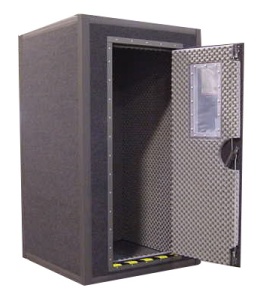What you can do in a sound booth
 This fall we purchased a VocalBooth sound recording booth for the Learning Technology Lab. We chose a 4-by-6-foot space that has room for one person, a chair, and a small table. My colleagues think it looks like Dr. Who’s Tardis …
This fall we purchased a VocalBooth sound recording booth for the Learning Technology Lab. We chose a 4-by-6-foot space that has room for one person, a chair, and a small table. My colleagues think it looks like Dr. Who’s Tardis …
Our booth is a tightly sealed space that greatly deadens – but does not eliminate – outside sound. Its egg crate foam lining takes care of any echoes and minor noises inside, while an outside fan quietly brings in air and circulates it throughout. We also purchased a Blue Yeti microphone (~$110) for the booth. It’s a favorite of podcasters and produces a truly warm sound. We’re very pleased with the results.
One can record audio on a tablet or smartphone, but we think our setup produces a much richer sound with greater fidelity. Choosing to produce higher quality media adds a level of professionalism to your message.
My student workers and I are already making good use of the space, and ND faculty are invited to reserve the booth (as are staff, postdocs, and grad students) for voice recordings and screencasts. A second VocalBooth that’s a bit larger is located in the Library’s Center for Digital Scholarship and is available to all members of the ND community.
What kinds of recordings can one make?
One option is a standalone voice-only recording that can be played by itself as an MP3 file. We also expect some people will use the booth to record voiceover tracks for video projects. Screencasting is a third option; it combines a video recording of the computer screen with voice narration. Recording live music is another way this kind of booth is used, but we don’t expect to see much of that. Our room only has room for a small instrument and it’s in a semi-public space.
Where does one post recordings?
If you visit our booth, we recommend that you save your work on a flash drive. After editing and exporting to MP3, you may choose to play it in a classroom directly from the flash drive or send it to students via email. If not, there are several ways to store sound files.
I’m a big fan of SoundCloud (see the player above). It’s a sort of “YouTube for sound” where many students follow new musical artists. You can also distribute sound files through Sakai or another LMS. More generically, Google Drive, Box, and other cloud storage services have built-in players and allow you to share files.
What kinds of content might one record?
- Formal essay, such as an audio narrative or “This I Believe“
- Language samples from people with varying accents
- Material for an online or “flipped” course
- StoryCorps-style interview (student-created example below)
- Screencast demonstration of a tool, technique, or process
- Where I’m from poem
- Public service announcement
- Prezi or PowerPoint presentation with narration
- Content for a listening comprehension exercise
- Elevator speech for an academic poster
- Narration of a digital story destined for an ePortfolio
- Rehearsal for a public speaking task
- Dramatic or interpretive reading from a literary work
- Project summary for an academic website
- Submission for a media competition (or a Remix badge at ND)
- A series of podcasts on course content
[Please use the comments to share more ideas and experiences.]
I have deliberately not mentioned the price we paid. If you are interested in a booth, I recommend contacting VocalBooth and other vendors like WhisperRoom and Gretch-Ken for information and quotes. Many different sizes and options are available. I have only good things to say about VocalBooth. They were very helpful and quick to respond. When the fire department said we had to use highly flame-retardant materials, VocalBooth said “no problem.” After I discovered I had made a big mistake on my order they took care of it speedily and fairly.
